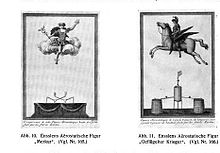Johann Carl Enslen
Johann Carl Enslen (born May 20, 1759 in Stuttgart , † December 10, 1848 in Dresden ) was a German travel painter, showman, panorama designer and pioneer of both aviation and photography .
Life
Enslen led a wandering life as a travel painter and showman at fairs, whereby his technical skill and his skills as a “mechanic” were in the foreground, while the artistic implementation was initially more focused on his brother and later on his son. He was determined by the first balloon flight in Montgolfière and together with his brother, the painter Gottfried Christian Enslen , from 1784 (for the first time in Strasbourg ) he let balloons rise, some of which were painted by him and his brother with allegorical figures. He went to the fairs with his exhibits and was so z. B. in 1788 and 1792 in Vienna as well as 1793 in Breslau . Johann Rudolph Becker reported about his appearance in Lübeck in 1789 :
“On October 8, 1789, the Mechanicus Enslen had various colossal figures, which were filled with combustible air, soar on the Bürger-Schützenhofe. First he sent a balloon in front of him, then followed a wild pig, which was pursued by a dog; Then a Reuter came on horseback, who hunted after the figures sent ahead; how a hunt in the air was presented. All of the figures swing to such a height that they have completely disappeared from the eyes of the audience. "
Enslen moved to Oliva near Danzig in 1795 and ran an iron foundry there. When his son Karl Georg Enslen went to school at the latest , he got in touch with the director of the Danzig Art School, Johann Adam Breysig , who was enthusiastic about panoramas and believed, even if mistakenly, to be the inventor of this new form of landscape presentation.
In 1811 the family moved to Berlin to fully exploit the talent of the son who paints. Enslen opened an optical- cosmoranic institute at Französische Straße 38, an optical cabinet in which he organized spectacular experimental demonstrations and which inspired ETA Hoffmann , among others . The son was accepted as a painter at the Berlin Academy (and later also its member), which the entire family understood to process in marketing. At the end of the 1810s, the Enslen family specialized in semi-circular panoramas, especially of European capitals, which became fairground attractions all over Germany.
Enslen moved to Dresden in 1834. In the spring of 1839 he began (at the age of 80) with photographic experiments on the model of Thomas Wedgwood and William Henry Fox Talbot . He is considered to be the first to produce paper prints in Germany. He life was not using the camera , but made the calotype related fotogenische drawings , nature and buildings or people combined.
Fonts
- Views and conjectures that the atmosphere surrounding the globe besides the spherical-arc-shaped refraction of rays ... must have an unknown peculiar refraction of light rays like a hollow sphere (etc.). Gärtner, Dresden 1834. ( urn : nbn: de: bvb: 12-bsb10133694-9 digitized BSB Munich).
- Try to explain the nature of light from its appearances. Dresden, Leipzig: Arnold 1841.
literature
- Victor Alexander Carus : Enslen, Johann Carl . In: Ulrich Thieme (Hrsg.): General Lexicon of Fine Artists from Antiquity to the Present . Founded by Ulrich Thieme and Felix Becker . tape 10 : Dubolon – Erlwein . EA Seemann, Leipzig 1914, p. 568 ( Textarchiv - Internet Archive ).
- Deac Rossell: Enslen, Johann Carl (1759-1848). In: John Hannavy (Ed.): Encyclopedia of Nineteenth-century Photography. Volume 1: A-I. CRC Press, New York 2007 ISBN 978-0-415-97235-2 , pp. 491-493.
Web links
- Biographical entry at the SLUB Dresden
- More pictures at zeno.org
- Richter, Regine (photographer) & Baumgarten, Friedrich August: Frontispiece with portrait of JC Enslen . Europeana. Retrieved October 22, 2013.
Individual evidence
- ^ Cumbersome history of the Kaiser. and salvation. Roman Empire freyen city of Lübeck. Volume 1. Lübeck 1805, p. 380.
- ↑ See the advertisement in Berlinische Nachrichten von Staats- und schehrten Dinge from July 29, 1813 ( books.google.com ).
- ↑ Rupert Gaderer: Poetics of Technology: Electricity and Optics at ETA Hoffmann. Freiburg, Br .: Rombach 2009 (Rombach Sciences, Edition Parabasen; Volume 9) ISBN 978-3-7930-9574-3 , p. 29.
- ^ Deac Rossell: Enslen, Johann Carl (1759-1848). In: John Hannavy (Ed.): Encyclopedia of Nineteenth-century Photography. Volume 1: A-I. P. 491.
| personal data | |
|---|---|
| SURNAME | Enslen, Johann Carl |
| ALTERNATIVE NAMES | Ensslen, Johann Carl; Enßlen, Johann Carl |
| BRIEF DESCRIPTION | German painter, showman, panorama designer and pioneer of photography |
| DATE OF BIRTH | May 20, 1759 |
| PLACE OF BIRTH | Stuttgart |
| DATE OF DEATH | December 10, 1848 |
| Place of death | Dresden |
